Purple flowers can help transform your garden by adding color, freshness, and elegance. But finding the best fit for your space can be a real challenge.
We have compiled a list of nine purple-flowered groundcovers to help you make an informed choice.
Here are nine of the best groundcover plants with purple flowers to make your garden attractive:
- Woolly Thyme
- Carpet Bugleweed
- Creeping Thyme
- Campanula ‘Birch Hybrid’ or Birch Hybrid Bellflower
- Lithodora ‘Celeste’
- Creeping Phlox ‘Violet Pinwheels’
- Spotted Deadnettle
- Winter Blooming Bergenia
- Purple Rock Cress
Table of Contents
1. Woolly Thyme
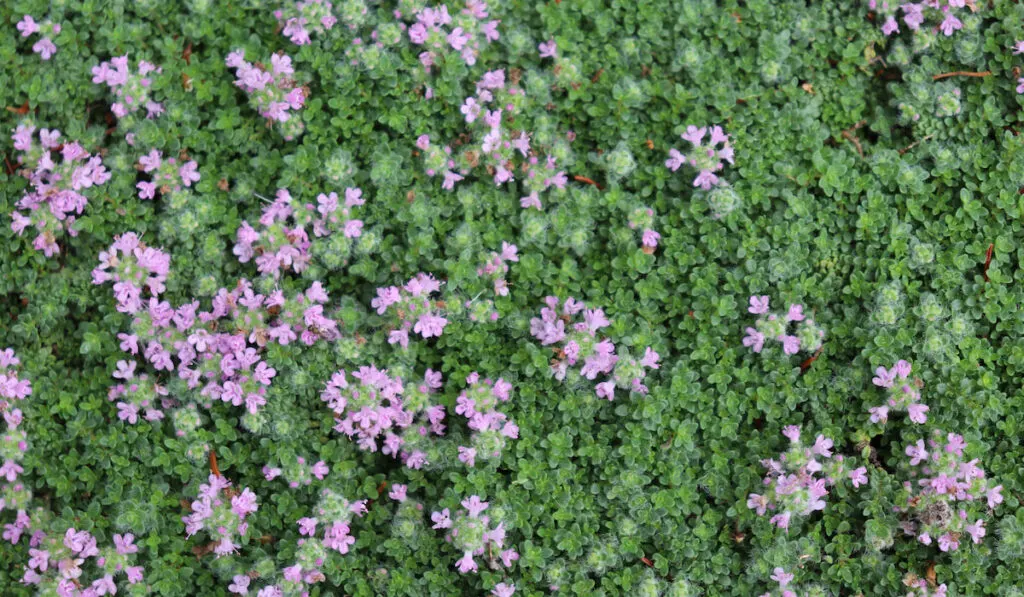
Woolly thyme is a low-growing, creeping shrub. It forms a dense carpet of hairy, tiny, non-fragrant leaves with tubular pink flowers.
Woolly thyme is the fuzziest thyme variant.
Woolly thyme suits rock gardens, walkways, stone walls, pond borders, and patios.
- Scientific name: Thymus pseudolanuginosus
- Blooming season: all summer
- Average size: grows 2 to 3 inches tall and spreads up to 1 foot
- Light requirement: full sun
- USDA hardiness zones: 5 to 8
- Suitable soil: well-drained loam
2. Carpet Bugleweed
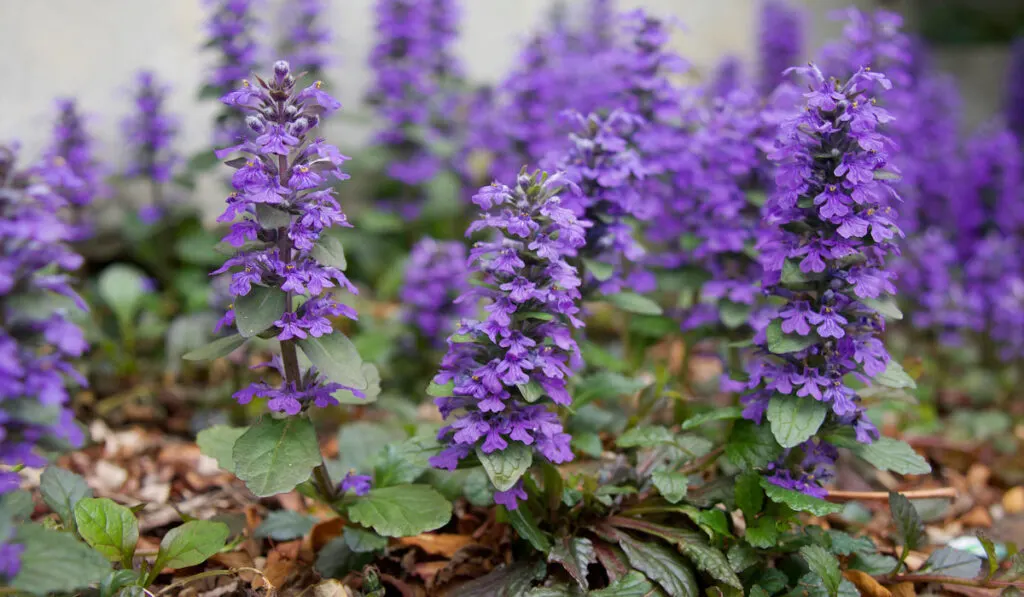
Bugleweed is a low-maintenance, evergreen perennial ground cover with colorful foliage.
Carpet bugleweed is best known for its breathtaking purple flower spikes and bronze, dark green, or variegated foliage, depending on the cultivar you plant.
The plant spreads rapidly through underground runners, forming a dense foliage mat.
Bugleweed is ideal for shady lawns, between stepping stones, and border edging. But it may become invasive, especially in well-watered gardens.
- Scientific name: Ajuga reptans
- Blooming season: mid- to late spring
- Average size: grows 3 to 6 inches tall and spreads 1 to 3 feet.
- Light requirement: part shade or full shade
- USDA hardiness zones: 4 to 9
- Suitable soil: medium to regularly moist, well-drained loamy, sandy, or clay soil.
3. Creeping Thyme

If you want a quickly spreading ground cover with purple flowers, creeping thyme is a perfect choice.
Creeping thyme is long-lasting, evergreen, and adaptive to diverse climatic conditions and soils.
This groundcover produces a dense carpet of small leaves with fragrant purple flowers.
- Scientific name: Thymus serpyllum
- Blooming season: early spring
- Average size: grows 1 to 2 inches tall and spreads 1 to 2 feet
- Light requirement: full sun
- USDA hardiness zones: 4 to 9
- Suitable soil: well-drained loamy, rocky, or sandy soil
4. ‘Birch Hybrid’ Bellflower

The ‘Birch Hybrid’ bellflower is an eye-catching, low-growing ground cover. It forms a trailing blanket of fresh, small green leaves.
Above the foliage arise erect, bell-shaped flowers that will paint your garden purple all summer through early fall.
This charming bellflower is well-behaved, evergreen, and spreads vigorously.
Bellflower is one of the most popular perennials, ideal for planting in rock gardens and crevices.
- Scientific name: Campanula portenschlagiana ‘Birch Hybrid’
- Blooming season: all summer to early fall
- Average size: grows 4 to 6 inches tall and spreads 8 inches to 1 foot
- Light requirement: part shade or full sun
- USDA hardiness zones: 4 to 9
- Suitable soil: moist, well-drained loam, chalk, or sand
5. Lithodora ‘Celeste’

Lithodora is an evergreen, mat-forming shrub that makes an excellent groundcover.
This plant blooms profusely, showing off vibrant star-shaped flowers. The blooms have five slightly cupped and well-proportioned petals.
The long, thin leaves are light green and arranged in rosettes along the stems, creating an eye-catching display.
The drought-tolerant Lithodora forms a cover to protect the soil and prevent weeds. Lithodora is ideal for the sides of pathways, rock gardens, and edging.
- Scientific name: Lithodora diffusa
- Blooming season: mid-spring through midsummer
- Average size: grows 2 to 4 inches tall and spreads 1 to 2 feet
- Light requirement: part shade or full sun
- USDA hardiness zones: 5 to 7
- Suitable soil: well-drained sand or loam
6. Creeping Phlox ‘Violet Pinwheels’
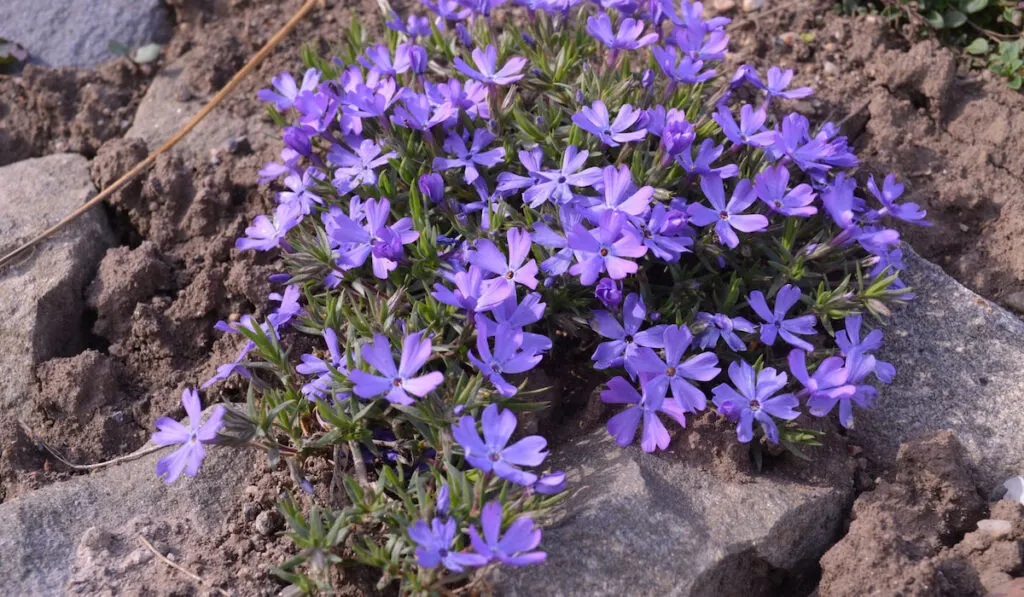
‘Violet Pinwheels’ is a unique creeping phlox ground cover variant: it blooms before all the other variants.
‘Violet Pinwheels’ has thick, needle-shaped dark green leaves and deep purple flowers. This variant spreads slowly, but it is effective against weeds once established.
This creeping phlox variant will bring your garden back to life in early spring.
In full bloom, the vibrant flowers completely cover the foliage, providing a beautiful purple spectacle.
This groundcover grows well in flower beds and rock gardens.
- Scientific name: Phlox subulate ‘Violet Pinwheels’
- Blooming season: all spring
- Average size: grows 3 to 5 inches tall and spreads 2 to 3 feet.
- Light requirement: full sun
- USDA hardiness zones: 4 to 9
- Suitable soil: well-drained and humus-rich loam, chalk- or sand-based soil
7. Spotted Deadnettle
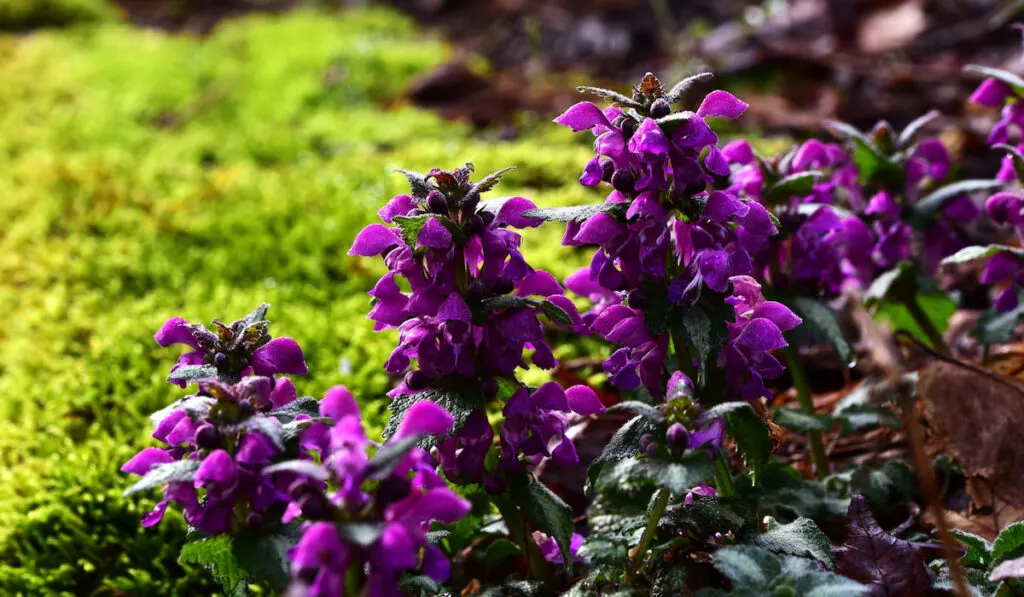
Spotted deadnettle is a drought-tolerant, herbaceous, easy-to-grow ground cover. Choose this groundcover if you want a plant that spreads quickly and is resistant to diseases and pests.
In bloom, spotted deadnettle produces beautiful purple, pink, lavender, and white flowers. Its flowers are small and speckled, hence the name.
Spotted deadnettle is suitable for areas of transition between sun and shade.
- Scientific name: Lamium maculatum
- Blooming season: late spring to early summer
- Average size: grows 6 to 9 inches tall and spreads 12 to 24 inches
- Light requirement: full sun or part shade
- USDA hardiness zones: 3 to 8
- Suitable soil: thrives in loamy, sandy, or clayey soil
8. Winter-blooming Bergenia

Winter-blooming Bergenia is a unique groundcover also known as elephant ears. It has thick, decorative foliage that keeps the soil moist and inhabitable for small animals.
Protruding above the foliage are elegant inflorescences, or cymes, of purple flowers.
The winter-blooming Bergenia is not drought-tolerant but thrives well in shady areas. This groundcover is ideal for planting under trees.
- Scientific name: Bergenia crassifolia
- Blooming season: winter to spring
- Average size: grows and spreads 1 to 2 feet
- Light requirement: part shade, full shade, or full sun
- USDA hardiness zones: 3 to 8
- Suitable soil: organic, moist loamy, sandy, and clay soils
9. Purple Rock Cress
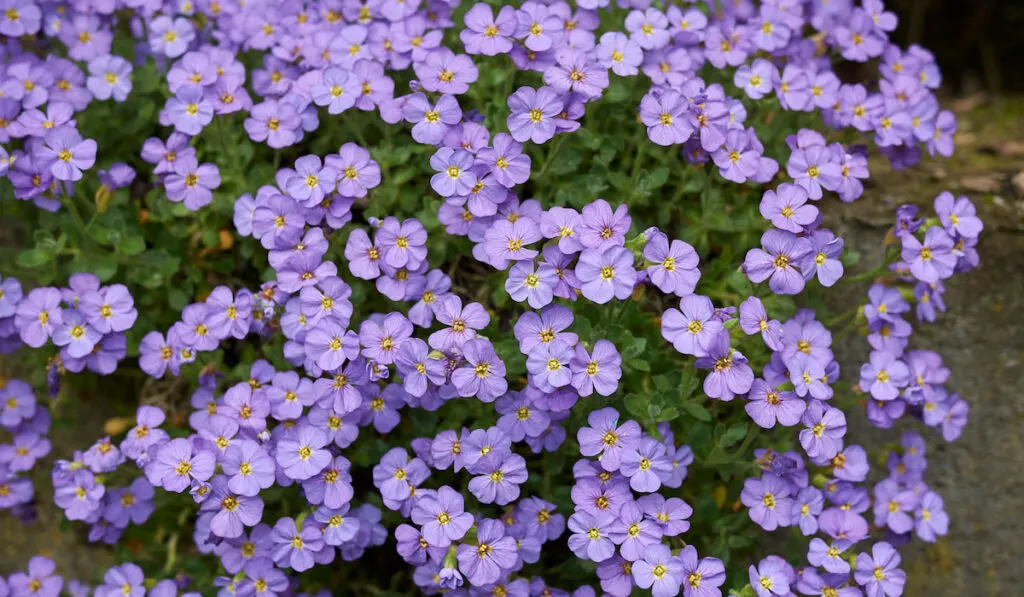
If you want a groundcover with sweet-looking purple flowers, rock cress could be the plant to choose.
Purple rock cress has small, dense, elliptical leaves with a bright mid-green shade. The flowers are pure purple with a light-yellow dot in the middle.
During full bloom, the blossoms cover the foliage, forming a pleasant display.
Rock cress best suits crevices, rock gardens, and stepping stones.
- Scientific name: Aubrieta deltoidea
- Blooming season: mid-spring until early summer
- Average size: grows 4 to 9 inches tall and spreads 1 to 2 feet
- Light requirement: part shade or full sun
- USDA hardiness zones: 4 to 7
- Suitable soil: well-drained loam, sand, or chalk
Final Thoughts
If you envision a living, purple carpet to decorate your garden, select one or a combination of plants from this guide. You should be able to find the right groundcover with purple flowers, no matter your climatic zone or soil type.
If you’re unsure about your climatic zone in the US, verify your zone using the USDA Plant Hardiness Zone Map.
Resources
- https://plants.ces.ncsu.edu/plants/ajuga-reptans/
- http://www.pnwplants.wsu.edu/PlantDisplay.aspx?PlantID=213
- https://extension.missouri.edu/publications/g6835
- https://planthardiness.ars.usda.gov/
- https://hort.extension.wisc.edu/articles/spotted-deadnettle-lamium-maculatum/
- https://plants.ces.ncsu.edu/plants/bergenia-crassifolia/
- http://www.pnwplants.wsu.edu/PlantDisplay.aspx?PlantID=99
- https://garden.org/plants/view/118519/Bellflower-Campanula-Birch-Hybrid/
